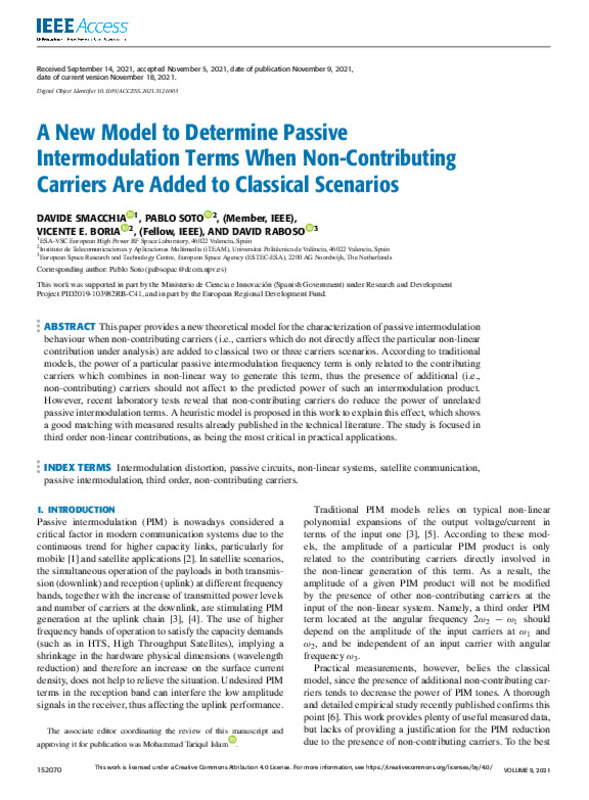JavaScript is disabled for your browser. Some features of this site may not work without it.
Buscar en RiuNet
Listar
Mi cuenta
Estadísticas
Ayuda RiuNet
Admin. UPV
A New Model to Determine Passive Intermodulation Terms When Non-Contributing Carriers are Added to Classical Scenarios
Mostrar el registro sencillo del ítem
Ficheros en el ítem
| dc.contributor.author | Smacchia, Davide
|
es_ES |
| dc.contributor.author | Soto Pacheco, Pablo
|
es_ES |
| dc.contributor.author | Boria Esbert, Vicente Enrique
|
es_ES |
| dc.contributor.author | Raboso García-Baquero, David
|
es_ES |
| dc.date.accessioned | 2022-10-05T18:03:07Z | |
| dc.date.available | 2022-10-05T18:03:07Z | |
| dc.date.issued | 2021 | es_ES |
| dc.identifier.uri | http://hdl.handle.net/10251/187085 | |
| dc.description.abstract | [EN] This paper provides a new theoretical model for the characterization of passive intermodulation behaviour when non-contributing carriers (i.e., carriers which do not directly affect the particular non-linear contribution under analysis) are added to classical two or three carriers scenarios. According to traditional models, the power of a particular passive intermodulation frequency term is only related to the contributing carriers which combines in non-linear way to generate this term, thus the presence of additional (i.e., non-contributing) carriers should not affect to the predicted power of such an intermodulation product. However, recent laboratory tests reveal that non-contributing carriers do reduce the power of unrelated passive intermodulation terms. A heuristic model is proposed in this work to explain this effect, which shows a good matching with measured results already published in the technical literature. The study is focused in third order non-linear contributions, as being the most critical in practical applications. | es_ES |
| dc.description.sponsorship | This work was supported in part by the Ministerio de Ciencia e Innovacion (Spanish Government) under Research and Development Project PID2019-103982RB-C41, and in part by the European Regional Development Fund. | es_ES |
| dc.language | Inglés | es_ES |
| dc.publisher | Institute of Electrical and Electronics Engineers | es_ES |
| dc.relation.ispartof | IEEE Access | es_ES |
| dc.rights | Reconocimiento (by) | es_ES |
| dc.subject | Intermodulation distortion | es_ES |
| dc.subject | Passive circuits | es_ES |
| dc.subject | Non-linear systems | es_ES |
| dc.subject | Satellite communication | es_ES |
| dc.subject | Passive intermodulation | es_ES |
| dc.subject | Third order | es_ES |
| dc.subject | Non-contributing carriers | es_ES |
| dc.subject.classification | TEORIA DE LA SEÑAL Y COMUNICACIONES | es_ES |
| dc.title | A New Model to Determine Passive Intermodulation Terms When Non-Contributing Carriers are Added to Classical Scenarios | es_ES |
| dc.type | Artículo | es_ES |
| dc.identifier.doi | 10.1109/ACCESS.2021.3126903 | es_ES |
| dc.relation.projectID | info:eu-repo/grantAgreement/AEI/Plan Estatal de Investigación Científica y Técnica y de Innovación 2017-2020/PID2019-103982RB-C41/ES/DISEÑO AVANZADO DE NUEVOS COMPONENTES DE ALTA FRECUENCIA EN TECNOLOGIAS GUIADAS COMPACTAS PARA FUTUROS SATELITES DE TELECOMUNICACION/ | es_ES |
| dc.rights.accessRights | Abierto | es_ES |
| dc.contributor.affiliation | Universitat Politècnica de València. Departamento de Comunicaciones - Departament de Comunicacions | es_ES |
| dc.description.bibliographicCitation | Smacchia, D.; Soto Pacheco, P.; Boria Esbert, VE.; Raboso García-Baquero, D. (2021). A New Model to Determine Passive Intermodulation Terms When Non-Contributing Carriers are Added to Classical Scenarios. IEEE Access. 9:152070-152074. https://doi.org/10.1109/ACCESS.2021.3126903 | es_ES |
| dc.description.accrualMethod | S | es_ES |
| dc.relation.publisherversion | https://doi.org/10.1109/ACCESS.2021.3126903 | es_ES |
| dc.description.upvformatpinicio | 152070 | es_ES |
| dc.description.upvformatpfin | 152074 | es_ES |
| dc.type.version | info:eu-repo/semantics/publishedVersion | es_ES |
| dc.description.volume | 9 | es_ES |
| dc.identifier.eissn | 2169-3536 | es_ES |
| dc.relation.pasarela | S\451008 | es_ES |
| dc.contributor.funder | AGENCIA ESTATAL DE INVESTIGACION | es_ES |
| dc.contributor.funder | European Regional Development Fund | es_ES |
| upv.costeAPC | 1850 | es_ES |








